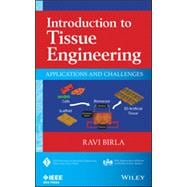A comprehensive reference and teaching aid on tissue engineering—covering everything from the basics of regenerative medicine to more advanced and forward thinking topics such as the artificial liver, bladder, and trachea
Regenerative medicine/tissue engineering is the process of replacing or regenerating human cells, tissues, or organs to restore or establish normal function. It is an incredibly progressive field of medicine that may, in the near future, help with the shortage of life-saving organs available through donation for transplantation.
Introduction to Tissue Engineering: Applications and Challenges makes tissue engineering more accessible to undergraduate and graduate students alike. It provides a systematic and logical eight-step process for tissue fabrication. Specific chapters have been dedicated to provide in-depth principles for many of the supporting and enabling technologies during the tissue fabrication process and include biomaterial development and synthesis, bioreactor design, and tissue vascularization. The tissue fabrication process is further illustrated with specific examples for liver, bladder, and trachea. Section-coverage includes an overall introduction of tissue engineering; enabling and supporting technologies; clinical applications; and case studies and future challenges.
Introduction to Tissue Engineering:
- Presents medical applications of stem cells in tissue engineering
- Deals with the effects of chemical stimulation (growth factors and hormones)
- Covers current disease pathologies and treatment options (pacemakers, prosthesis)
- Explains bioengineering, design and fabrication, and critical challenges during tissue fabrication
- Offers PowerPoint slides for instructors
- Features case studies and a section on future directions and challenges
As pioneering individuals look ahead to the possibility of generating entire organ systems, students may turn to this text for a comprehensive understanding and preparation for the future of regenerative medicine.








